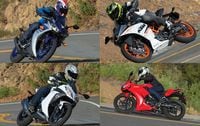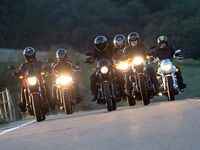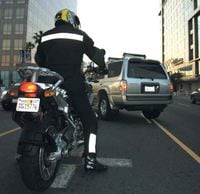Beginner’s Guide To Motorcycles
Learn what gear you need, how to ride, and hit the road with Motorcyclist.
Riding a motorcycle is not necessarily dangerous, but compared to automobile drivers, motorcyclists are more prone to injuries when involved in crashes. There is no metal cage with crumple zones and airbags to protect you, just the gear that you are wearing. Good thing for riders, that protective gear is improving as time progresses. As a beginner motorcyclist, you have to decide if this is a risk you want to take.
Motorcyclist has developed this beginner’s guide to motorcycles to welcome new riders and send them down the correct path—to set you up with everything you need, including how to get licensed, gear recommendations, and the best beginner motorcycles.
Obtaining Your Motorcycle License Or Endorsement
The first step in deciding if want to become a motorcyclist is by obtaining your motorcycle permit, license, or motorcycle endorsement. Some states require you to pass a Motorcycle Safety Foundation (MSF) Basic RiderCourse to obtain a license. This course is also the perfect place to decide if a motorcycle is for you, considering they cost less than buying a motorcycle, insurance, gear, and then figuring out that riding is not for you.
Each state has a different combination of written and physical skills proficiency test that you must pass to demonstrate your ability as a motorcyclist. If you are unsure of your state’s prerequisites, check with your local DMV and it will provide you with the current information.
Beginner Motorcycle Gear
Now that you are allowed to lawfully operate a motorcycle in your state, the next step is gathering the safety gear needed. Some states do not require you to wear a helmet while you operate a motorcycle, but we strongly recommend a Snell and/or DOT-certified helmet when you ride.
Your motorcycle helmet must be DOT-certified to be street legal. There are other safety certifications, such as Snell, ECE, and SHARP, all of which have their testing standards and some are more stringent than others. A full-face helmet from any one of the popular helmet manufacturers will provide you with the protection you need.
A motorcycle jacket designed for riding is equally as important. This means the jacket has abrasion resistance as well as CE-approved armor, or with pockets to add armor. The jacket should be made of durable textile or leather and the armor should be on the shoulders, elbows, chest, and back. Some jackets do come with spine protectors, while others might have inserts or buttons to attach your own.
Casual-wear jeans will not do anything for you in a crash or slide, they might protect you better than a pair of shorts but expect road rash or worse. Motorcycle pants are made out of the same materials as your jacket. Proper motorcycle pants will have armor in the knees, hips, and tailbone, with sportier pants having knee pucks. There are motorcycle jeans with integrated armor that are available for purchase, but regular department store denim will not cut it.
Motorcycle gloves need to protect your palms, knuckles, and wrists, so skip the padded mechanic gloves and dirt bike gloves, most will protect you from a low-side slide, but not from any serious impact. Look for motorcycle gloves with molded knuckles, palms, and wrist protection. Some higher-end gloves will have a ring-pinky bridge—to prevent hyperextension— and palm sliders, but these features are not necessary for your beginner set of gloves.
Motorcycle boots are one of the most underrated pieces of gear that a beginner considers when building out their kit. Boots should protect your toes, the soles of your feet, heels, and ankles without compromising your ability to use the foot controls on a motorcycle. Most manufacturers have boots in different styles, to suit whatever kind of riding you do or appeal to the trends you like to wear, all offering protection to your ankles and feet in case of an accident.
Best Beginner Motorcycle
If you have ever thought, “What is the best beginner motorcycle?” you are not the only one. Motorcycling is a niche mode of transportation, and if you are new to the industry, your basis of knowledge is limited. We have researched and developed guides to help you choose the best beginner motorcycle.
We have compared small cruisers and small sportbikes to determine which of them was the best in class for beginners. If you are short and want a cruiser—or short and do not want a cruiser—there are beginner motorcycles that are easy to swing your leg over. Wondering if you should buy new, or should go the used motorcycle route? No problem. If you want to save some money on your motorcycle purchase—maybe to put that cash toward proper beginner gear—then we have got some suggestions.
Choosing Your First Motorcycle
Your first motorcycle will be the most valuable one you ever own. Not in terms of cost, but it will be where you learn how to ride, where you develop good—and bad—riding habits, and where you will fall in love with motorcycling. Here are some things to consider before you hand over the cash for your first bike.
You can buy your first bike new or used. Both come with their pros and cons. If you are buying new, buy a motorcycle you feel comfortable on. Ask the dealer for a test ride, or two. If you buy used, purchase a motorcycle that has been taken care of. Stay away from motorcycles without complete service history or have a salvage, rebuilt, or missing title. The bike might have an attractive price, but it is not worth the headache.
Buy a motorcycle that you know you can handle. Meaning, do not buy a bike that is too heavy for you to pick up and do not buy a first motorcycle that has too much power. A small-displacement (250cc to 500cc) motorcycle is a great option because they are considerably light, have enough power to maintain highway speeds, and have beginner-friendly power delivery. It might be tempting to buy a new inline-4 sportbike but resist that urge, at least until you develop your skills.
Beginner Motorcycle Classes
Beginner motorcycle classes, if your state does not require you to pass one to obtain your motorcycle license, are a great way to grow your skills as a rider. Organizations like the MSF offer courses that go beyond the beginner motorcycle tips you hear from your friends. They also have classes for scooter riders as well as trikes and sidecars
Nothing beats the one-on-one beginner motorcycle courses when you are new to riding, but we have compiled some tips from seasoned motorcycle riders that you should always be aware of when you are riding. Also, if you are looking to increase your skills as a new motorcycle rider without the fear of traffic, a trackday is always a great place.


/cloudfront-us-east-1.images.arcpublishing.com/octane/XMID3K3E5NHAPITRPSPDNPAAIY.jpg)
/cloudfront-us-east-1.images.arcpublishing.com/octane/KP24TKKRANALLF4NXB4LUUAL2Q.jpg)
/cloudfront-us-east-1.images.arcpublishing.com/octane/FR5PSME7GBCMZKYUIB7BRCTGUU.jpg)



/cloudfront-us-east-1.images.arcpublishing.com/octane/TSO2ZHKGDCVP3OOBSK3VA6H3ZI.jpg)

/cloudfront-us-east-1.images.arcpublishing.com/octane/AJEGHZ35TBC33B3LWN7OX5QTRM.jpg)





/cloudfront-us-east-1.images.arcpublishing.com/octane/4MRUUFB64BGHFKRPIPIRGSC5EM.jpg)
/cloudfront-us-east-1.images.arcpublishing.com/octane/WCHT7K5N6EMNHP7ZWWRVOUB62M.jpg)